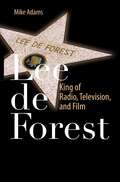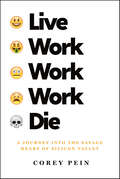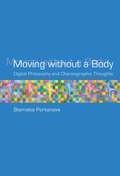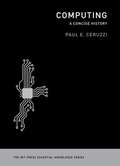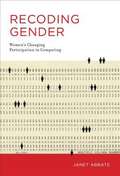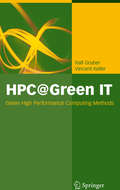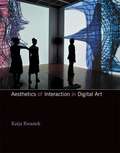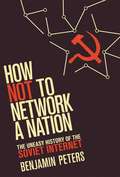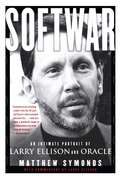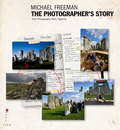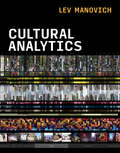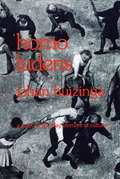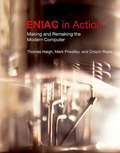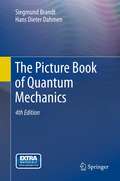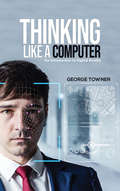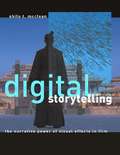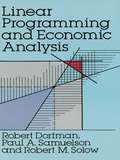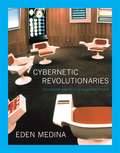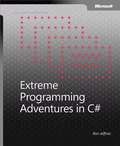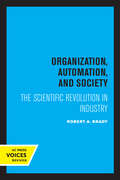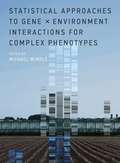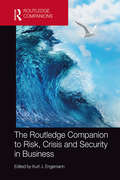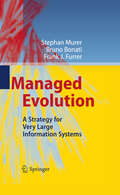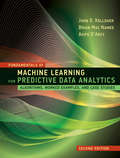- Table View
- List View
Lee de Forest
by Mike AdamsThe life-long inventor, Lee de Forest invented the three-element vacuum tube used between 1906 and 1916 as a detector, amplifier, and oscillator of radio waves. Beginning in 1918 he began to develop a light valve, a device for writing and reading sound using light patterns. While he received many patents for his process, he was initially ignored by the film industry. In order to promote and demonstrate his process he made several hundred sound short films, he rented space for their showing; he sold the tickets and did the publicity to gain audiences for his invention. Lee de Forest officially brought sound to film in 1919. Lee De Forest: King of Radio, Television, and Film is about both invention and early film making; de Forest as the scientist and producer, director, and writer of the content. This book tells the story of de Forest's contribution in changing the history of film through the incorporation of sound. The text includes primary source historical material, U.S. patents and richly-illustrated photos of Lee de Forest's experiments. Readers will greatly benefit from an understanding of the transition from silent to audio motion pictures, the impact this had on the scientific community and the popular culture, as well as the economics of the entertainment industry.
Turing's Legacy: Developments from Turing's Ideas in Logic
by Rod DowneyAlan Turing was an inspirational figure who is now recognised as a genius of modern mathematics. In addition to leading the Allied forces' code-breaking effort at Bletchley Park in World War II, he proposed the theoretical foundations of modern computing and anticipated developments in areas from information theory to computer chess. His ideas have been extraordinarily influential in modern mathematics and this book traces such developments by bringing together essays by leading experts in logic, artificial intelligence, computability theory and related areas. Together, they give insight into this fascinating man, the development of modern logic, and the history of ideas. The articles within cover a diverse selection of topics, such as the development of formal proof, differing views on the Church–Turing thesis, the development of combinatorial group theory, and Turing's work on randomness which foresaw the ideas of algorithmic randomness that would emerge many years later.
Live Work Work Work Die: A Journey into the Savage Heart of Silicon Valley
by Corey PeinA scathing, sardonic exploration of Silicon Valley tech culture, laying bare the greed, hubris, and retrograde politics of an industry that aspires to radically transform society for its own benefitAt the height of the startup boom, journalist Corey Pein set out for Silicon Valley with little more than a smartphone and his wits. His goal: to learn how such an overhyped industry could possibly sustain itself as long as it has. But to truly understand the delirious reality of the tech entrepreneurs, he knew he would have to inhabit that perspective—he would have to become an entrepreneur himself. Thus Pein begins his journey—skulking through gimmicky tech conferences, pitching his over-the-top business ideas to investors, and rooming with a succession of naive upstart programmers whose entire lives are managed by their employers—who work endlessly and obediently, never thinking to question their place in the system.In showing us this frantic world, Pein challenges the positive, feel-good self-image that the tech tycoons have crafted—as nerdy and benevolent creators of wealth and opportunity—revealing their self-justifying views and their insidious visions for the future. Vivid and incisive, Live Work Work Work Die is a troubling portrait of a self-obsessed industry bent on imposing its disturbing visions on the rest of us.
Moving without a Body
by Stamatia PortanovaDigital technologies offer the possibility of capturing, storing, and manipulating movement, abstracting it from the body and transforming it into numerical information. In Moving without a Body, Stamatia Portanova considers what really happens when the physicality of movement is translated into a numerical code by a technological system. Drawing on the radical empiricism of Gilles Deleuze and Alfred North Whitehead, she argues that this does not amount to a technical assessment of software's capacity to record motion but requires a philosophical rethinking of what movement itself is, or can become. Discussing the development of different audiovisual tools and the shift from analog to digital, she focuses on some choreographic realizations of this evolution, including works by Loie Fuller and Merce Cunningham. Throughout, Portanova considers these technologies and dances as ways to think -- rather than just perform or perceive -- movement. She distinguishes the choreographic thought from the performance: a body performs a movement, and a mind thinks or choreographs a dance. Similarly, she sees the move from analog to digital as a shift in conception rather than simply in technical realization. Analyzing choreographic technologies for their capacity to redesign the way movement is thought, Moving without a Body offers an ambitiously conceived reflection on the ontological implications of the encounter between movement and technological systems.
Computing
by Paul E. CeruzziThe history of computing could be told as the story of hardware and software, or the story of the Internet, or the story of "smart" hand-held devices, with subplots involving IBM, Microsoft, Apple, Facebook, and Twitter. In this concise and accessible account of the invention and development of digital technology, computer historian Paul Ceruzzi offers a broader and more useful perspective. He identifies four major threads that run throughout all of computing's technological development: digitization--the coding of information, computation, and control in binary form, ones and zeros; the convergence of multiple streams of techniques, devices, and machines, yielding more than the sum of their parts; the steady advance of electronic technology, as characterized famously by "Moore's Law"; and the human-machine interface. Ceruzzi guides us through computing history, telling how a Bell Labs mathematician coined the word "digital" in 1942 (to describe a high-speed method of calculating used in anti-aircraft devices), and recounting the development of the punch card (for use in the 1890 U. S. Census). He describes the ENIAC, built for scientific and military applications; the UNIVAC, the first general purpose computer; and ARPANET, the Internet's precursor. Ceruzzi's account traces the world-changing evolution of the computer from a room-size ensemble of machinery to a "minicomputer" to a desktop computer to a pocket-sized smart phone. He describes the development of the silicon chip, which could store ever-increasing amounts of data and enabled ever-decreasing device size. He visits that hotbed of innovation, Silicon Valley, and brings the story up to the present with the Internet, the World Wide Web, and social networking.
Recoding Gender
by Janet AbbateToday, women earn a relatively low percentage of computer science degrees and hold proportionately few technical computing jobs. Meanwhile, the stereotype of the male "computer geek" seems to be everywhere in popular culture. Few people know that women were a significant presence in the early decades of computing in both the United States and Britain. Indeed, programming in postwar years was considered woman's work (perhaps in contrast to the more manly task of building the computers themselves). In Recoding Gender, Janet Abbate explores the untold history of women in computer science and programming from the Second World War to the late twentieth century. Demonstrating how gender has shaped the culture of computing, she offers a valuable historical perspective on today's concerns over women's underrepresentation in the field. Abbate describes the experiences of women who worked with the earliest electronic digital computers: Colossus, the wartime codebreaking computer at Bletchley Park outside London, and the American ENIAC, developed to calculate ballistics. She examines postwar methods for recruiting programmers, and the 1960s redefinition of programming as the more masculine "software engineering." She describes the social and business innovations of two early software entrepreneurs, Elsie Shutt and Stephanie Shirley; and she examines the career paths of women in academic computer science. Abbate's account of the bold and creative strategies of women who loved computing work, excelled at it, and forged successful careers will provide inspiration for those working to change gendered computing culture.
HPC@Green IT
by Ralf Gruber Vincent Keller Erich StrohmaierThe authors present methods to reduce computer energy consumption by means of a better usage of a specific set of resources and maximizing the efficiency of the running applications. The processor frequency is adjusted to the needs of the running job, leading to a power drop by a factor of 2 and doubling battery life time of laptops. It is shown how computer resources can be optimally adapted to application needs, reducing job run time. Examples on how to optimize algorithms on single node and parallel RISC architectures are discussed. The job-related data are stored and reused to help computer managers to replace machines.
Aesthetics of Interaction in Digital Art
by Katja Kwastek Niamh WardeSince the 1960s, artworks that involve the participation of the spectator have received extensive scholarly attention. Yet interactive artworks using digital media still present a challenge for academic art history. In this book, Katja Kwastek argues that the particular aesthetic experience enabled by these new media works can open up new perspectives for our understanding of art and media alike. Kwastek, herself an art historian, offers a set of theoretical and methodological tools that are suitable for understanding and analyzing not only new media art but also other contemporary art forms. Addressing both the theoretician and the practitioner, Kwastek provides an introduction to the history and the terminology of interactive art, a theory of the aesthetics of interaction, and exemplary case studies of interactive media art. Kwastek lays the historical and theoretical groundwork with discussions of processual strategies of twentieth-century art and theories of aesthetic experience, process aesthetics, play, and performance. She then develops an aesthetics of interaction, discussing such aspects as real space and data space, temporal structures, instrumental and phenomenal perspectives, and the relationship between materiality and interpretability. Finally, she applies her theory to specific works of interactive media art, including narratives in virtual and real space, interactive installations, and performance -- with case studies of works by Olia Lialina, Susanne Berkenheger, Stefan Schemat, Teri Rueb, Lynn Hershman, Agnes Heged's, Tmema, David Rokeby, Sonia Cillari, and Blast Theory.
How Not to Network a Nation: The Uneasy History of the Soviet Internet
by Benjamin PetersBetween 1959 and 1989, Soviet scientists and officials made numerous attempts to network their nation -- to construct a nationwide computer network. None of these attempts succeeded, and the enterprise had been abandoned by the time the Soviet Union fell apart. Meanwhile, ARPANET, the American precursor to the Internet, went online in 1969. Why did the Soviet network, with top-level scientists and patriotic incentives, fail while the American network succeeded? In How Not to Network a Nation, Benjamin Peters reverses the usual cold war dualities and argues that the American ARPANET took shape thanks to well-managed state subsidies and collaborative research environments and the Soviet network projects stumbled because of unregulated competition among self-interested institutions, bureaucrats, and others. The capitalists behaved like socialists while the socialists behaved like capitalists. After examining the midcentury rise of cybernetics, the science of self-governing systems, and the emergence in the Soviet Union of economic cybernetics, Peters complicates this uneasy role reversal while chronicling the various Soviet attempts to build a "unified information network." Drawing on previously unknown archival and historical materials, he focuses on the final, and most ambitious of these projects, the All-State Automated System of Management (OGAS), and its principal promoter, Viktor M. Glushkov. Peters describes the rise and fall of OGAS -- its theoretical and practical reach, its vision of a national economy managed by network, the bureaucratic obstacles it encountered, and the institutional stalemate that killed it. Finally, he considers the implications of the Soviet experience for today's networked world.
Softwar: An Intimate Portrait of Larry Ellison and Oracle
by Matthew SymondsIn a business where great risks, huge fortunes, and even bigger egos are common, Larry Ellison stands out as one of the most outspoken, driven, and daring leaders of the software industry. The company he cofounded and runs, Oracle, is the number one business software company: perhaps even more than Microsoft's, Oracle's products are essential to today's networked world.But Oracle is as controversial as it is influential, as feared as it is revered, thanks in large part to Larry Ellison. Though Oracle is one of the world's most valuable and profitable companies, Ellison is not afraid to suddenly change course and reinvent Oracle in the pursuit of new and ever more ambitious goals. Softwar examines the results of these shifts in strategy and the forces that drive Ellison relentlessly on.In Softwar, journalist Matthew Symonds gives readers an exclusive and intimate insight into both Oracle and the man who made it and runs it. As well as relating the story of Oracle's often bumpy path to industry dominance, Symonds deals with the private side of Ellison's life. From Ellison's troubled upbringing by adoptive parents and his lifelong search for emotional security to the challenges and opportunities that have come with unimaginable wealth, Softwar gets inside the skin of a fascinating and complicated human being. With unlimited insider access granted by Ellison himself, Symonds captures the intensity and, some would say, the recklessness that have made Ellison a legend.The result of more than a hundred hours of interviews and many months spent with Ellison, Softwar is the most complete portrait undertaken of the man and his empire -- a unique and gripping account of both the way the computing industry really works and an extraordinary life.Despite his closeness to Ellison, Matthew Symonds is a candid and at times highly critical observer. And in perhaps the book's most unusual feature, Ellison responds to Symonds's portrayal in the form of a running footnoted commentary.The result is one of the most fascinating business stories of all time.
The Photographer's Story: The Art of Visual Narrative
by Michael FreemanHaving already taught you how to compose and interpret great photos, Michael Freeman now continues his best-selling series by exploring the most successful methods for presenting photography meaningfully and in an engaging format. This is the critical "next step" that separates adequate image galleries from captivating collections - and disinterested viewers from enthralled audiences.Tapping into his decades of experience shooting for such publications as Smithsonian, GEO, and Condé Nast Traveller (among many others), Michael Freeman studies the photo-essay phenomenon that took the world by storm and gave storytellers a completely new set of tools to construct their narratives. Having established how rhythm, pacing, and careful organisation build tension and cultivate interest, Freeman goes on to explain what this means for presenting your own photos, particularly in the new digital formats of online galleries, slideshows, and tablets.The Photographer's Story will enliven your images, refresh your perspective, and elevate your understanding of how photographs work together to tell a story. Your audiences will thank you for it.
Cultural Analytics
by Lev ManovichA book at the intersection of data science and media studies, presenting concepts and methods for computational analysis of cultural data.How can we see a billion images? What analytical methods can we bring to bear on the astonishing scale of digital culture--the billions of photographs shared on social media every day, the hundreds of millions of songs created by twenty million musicians on Soundcloud, the content of four billion Pinterest boards? In Cultural Analytics, Lev Manovich presents concepts and methods for computational analysis of cultural data. Drawing on more than a decade of research and projects from his own lab, Manovich offers a gentle, nontechnical introduction to the core ideas of data analytics and discusses the ways that our society uses data and algorithms.
Homo Ludens
by Johan Huizinga"A happier age than ours once made bold to call our species by the name of Homo Sapiens. In the course of time we have come to realize that we are not so reasonable after all as the Eighteenth Century with its worship of reason and naive optimism, though us; "hence moder fashion inclines to designate our species as Homo Faber: Man the Maker. But though faber may not be quite so dubious as sapiens it is, as a name specific of the human being, even less appropriate, seeing that many animals too are makers. There is a third function, howver, applicable to both human and animal life, and just as important as reasoning and making--namely, playing. it seems to me that next to Homo Faber, and perhaps on the same level as Homo Sapiens, Homo Ludens, Man the Player, deserves a place in our nomenclature."--from the Foreward, by Johan Huizinga
ENIAC in Action: Making and Remaking the Modern Computer
by Mark Priestley Crispin Rope Thomas HaighConceived in 1943, completed in 1945, and decommissioned in 1955, ENIAC (the Electronic Numerical Integrator and Computer) was the first general-purpose programmable electronic computer. But ENIAC was more than just a milestone on the road to the modern computer. During its decade of operational life, ENIAC calculated sines and cosines and tested for statistical outliers, plotted the trajectories of bombs and shells, and ran the first numerical weather simulations. ENIAC in Action tells the whole story for the first time, from ENIAC's design, construction, testing, and use to its afterlife as part of computing folklore. It highlights the complex relationship of ENIAC and its designers to the revolutionary approaches to computer architecture and coding first documented by John von Neumann in 1945.Within this broad sweep, the authors emphasize the crucial but previously neglected years of 1947 to 1948, when ENIAC was reconfigured to run what the authors claim was the first modern computer program to be executed: a simulation of atomic fission for Los Alamos researchers. The authors view ENIAC from diverse perspectives -- as a machine of war, as the "first computer," as a material artifact constantly remade by its users, and as a subject of (contradictory) historical narratives. They integrate the history of the machine and its applications, describing the mathematicians, scientists, and engineers who proposed and designed ENIAC as well as the men -- and particularly the women who -- built, programmed, and operated it.
The Picture Book of Quantum Mechanics
by Hans Dieter Dahmen Siegmund BrandtThe aim of this book is to explain the basic concepts and phenomena of quantum mechanics by means of visualization. Computer-generated illustrations in color are used extensively throughout the text, helping to establish the relation between quantum mechanics--wave functions, interference, atomic structure, and so forth--and classical physics--point mechanics, statistical mechanics, and wave optics. Even more important, by studying the pictures in parallel with the text, readers develop an intuition for such notoriously abstract phenomena as the tunnel effect excitation and decay of metastable states wave-packet motion within a well systems of distinguishable and indistinguishable particles free wave packets and scattering in 3 dimensions angular-momentum decomposition stationary bound states in various 3-dimensional potentials hybrid states Kepler motion of wave packets in the Coulomb field spin and magnetic resonance Illustrations from experiments in a variety of fields, including chemistry, and molecular, atomic, nuclear, and particle physics, underline the basic as well as the practical importance of quantum mechanics. In the present, fourth edition all computer graphics are presented in full color. It also contains additional physics topics such as hybridization. Praise for Previous Editions "The book is highly recommended as a complement to any standard textbook in quantum mechanics, but it will also be valuable to all of us who studied quantum mechanics without the pictures." -- International Journal of Quantum Chemistry "This book would be an excellent basis for the study of special topics in a quantum physics course. Most serious students of physics and all of their teachers will want to consider having this orderly and graphic outline of introductory quantum theory at their fingertips." -- American Journal of Physics "Their aim is the presentation of the 'principal ideas of wave mechanics' in such a way that students can build a quantum intuition out of their graphics." -- Scientific American "This is a unique book. It does not provide a complete course in quantum theory, but as a companion work of reference it should be quite useful to students in providing insights into the dynamical structure of the theory." -- Nature
Thinking Like a Computer: An Introduction to Digital Reality
by George TownerThinking Like a Computer is the result of a detailed 30-year study of how computers imitate life.Although they are machines, computers are designed to act like human beings. Software is specifically created to help accomplish human-like tasks and to be understood in human terms. Yet unlike human life, computer operations can be analyzed in detail because we build the machines that accomplish them and we know the design decisions that make them work.With every choice made during the evolution of digital technology, computer architects have intuitively or consciously incorporated truths of human functioning into their designs.Thinking Like a Computer is based on these truths, assembling them into a new explanation of human knowledge. In addition, it provides insights into the foundations of theoretical science because much of digital technology is dedicated to creating new realities.
Digital Storytelling
by Shilo T. MccleanComputer-generated effects are often blamed for bad Hollywood movies. Yet when a critic complains that "technology swamps storytelling" (in a review of Van Helsing, calling it "an example of everything that is wrong with Hollywood computer-generated effects movies"), it says more about the weakness of the story than the strength of the technology. In Digital Storytelling, Shilo McClean shows how digital visual effects can be a tool of storytelling in film, adding narrative power as do sound, color, and "experimental" camera angles--other innovative film technologies that were once criticized for being distractions from the story. It is time, she says, to rethink the function of digital visual effects. Effects artists say--contrary to the critics--that effects always derive from story. Digital effects are a part of production, not post-production; they are becoming part of the story development process. Digital Storytelling is grounded in filmmaking, the scriptwriting process in particular. McClean considers crucial questions about digital visual effects-- whether they undermine classical storytelling structure, if they always call attention to themselves, whether their use is limited to certain genres--and looks at contemporary films (including a chapter-long analysis of Steven Spielberg's use of computer-generated effects) and contemporary film theory to find the answers. McClean argues that to consider digital visual effects as simply contributing the "wow" factor underestimates them. They are, she writes, the legitimate inheritors of film storycraft.
Linear Programming and Economic Analysis (Dover Books on Computer Science)
by Paul A. Samuelson Robert M. Solow Robert DorfmanDesigned primarily for economists and those interested in management economics who are not necessarily accomplished mathematicians, this text offers a clear, concise exposition of the relationship of linear programming to standard economic analysis. The research and writing were supported by The RAND Corporation in the late 1950s.Linear programming has been one of the most important postwar developments in economic theory, but until publication of the present volume, no text offered a comprehensive treatment of the many facets of the relationship of linear programming to traditional economic theory. This book was the first to provide a wide-ranging survey of such important aspects of the topic as the interrelations between the celebrated von Neumann theory of games and linear programming, and the relationship between game theory and the traditional economic theories of duopoly and bilateral monopoly.Modern economists will especially appreciate the treatment of the connection between linear programming and modern welfare economics and the insights that linear programming gives into the determinateness of Walrasian equilibrium. The book also offers an excellent introduction to the important Leontief theory of input-output as well as extensive treatment of the problems of dynamic linear programming. Successfully used for three decades in graduate economics courses, this book stresses practical problems and specifies important concrete applications.
Cybernetic Revolutionaries
by Eden MedinaIn Cybernetic Revolutionaries, Eden Medina tells the history of two intersecting utopian visions, one political and one technological. The first was Chile's experiment with peaceful socialist change under Salvador Allende; the second was the simultaneous attempt to build a computer system that would manage Chile's economy. Neither vision was fully realized--Allende's government ended with a violent military coup; the system, known as Project Cybersyn, was never completely implemented--but they hold lessons for today about the relationship between technology and politics. Drawing on extensive archival material and interviews, Medina examines the cybernetic system envisioned by the Chilean government--which was to feature holistic system design, decentralized management, human-computer interaction, a national telex network, near real-time control of the growing industrial sector, and modeling the behavior of dynamic systems. She also describes, and documents with photographs, the network's Star Trek-like operations room, which featured swivel chairs with armrest control panels, a wall of screens displaying data, and flashing red lights to indicate economic emergencies. Studying project Cybersyn today helps us understand not only the technological ambitions of a government in the midst of political change but also the limitations of the Chilean revolution. This history further shows how human attempts to combine the political and the technological with the goal of creating a more just society can open new technological, intellectual, and political possibilities. Technologies, Medina writes, are historical texts; when we read them we are reading history.
Extreme Programming Adventures in C#
by Ron JeffriesSee eXtreme Programming (XP) in action at the hands of an XP master--and learn Microsoft .NET and C# programming in the process! In this fast-paced, hands-on exposition, Ron Jeffries--one of the leading voices and practitioners in the XP community--demonstrates that you can write well-designed, resilient code incrementally and safely, while minimizing your investment in speculative up-front design. As Jeffries builds his sample application, you get firsthand insights into what successful XP development looks like, complete with real-world challenges such as the eleventh-hour change order. For further practice and study, you can download all the author's code--including the missteps--so you can see XP and agile concepts in action and assess how they fit into your own work. Pair program with an XP master, discovering how to: Streamline and simplify the software development process Work more effectively as part of an XP development team Reduce missteps by designing, testing, and refining code in increments Receive clearer specifications and feedback from customers Write cleaner, more expressive code--and weed out more bugs Conserve resources by planning and reassessing progress as you go Maintain a sustainable work pace--and avoid burnout Step up delivery dates, shipping the most crucial features first Improve customer satisfaction!
Organization, Automation, and Society: The Scientific Revolution in Industry
by Robert A. BradyThis title is part of UC Press's Voices Revived program, which commemorates University of California Press’s mission to seek out and cultivate the brightest minds and give them voice, reach, and impact. Drawing on a backlist dating to 1893, Voices Revived makes high-quality, peer-reviewed scholarship accessible once again using print-on-demand technology. This title was originally published in 1961.
Statistical Approaches to Gene x Environment Interactions for Complex Phenotypes
by Michael WindleFindings from the Human Genome Project and from Genome-Wide Association (GWA) studies indicate that many diseases and traits manifest a more complex genomic pattern than previously assumed. These findings, and advances in high-throughput sequencing, suggest that there are many sources of influence -- genetic, epigenetic, and environmental. This volume investigates the role of the interactions of genes and environment (G × E) in diseases and traits (referred to by the contributors as complex phenotypes) including depression, diabetes, obesity, and substance use. The contributors first present different statistical approaches or strategies to address G × E and G × G interactions with high-throughput sequenced data, including two-stage procedures to identify G × E and G × G interactions, marker-set approaches to assessing interactions at the gene level, and the use of a partial-least square (PLS) approach. The contributors then turn to specific complex phenotypes, research designs, or combined methods that may advance the study of G × E interactions, considering such topics as randomized clinical trials in obesity research, longitudinal research designs and statistical models, and the development of polygenic scores to investigate G × E interactions.ContributorsFatima Umber Ahmed, Yin-Hsiu Chen, James Y. Dai, Caroline Y. Doyle, Zihuai He, Li Hsu, Shuo Jiao, Erin Loraine Kinnally, Yi-An Ko, Charles Kooperberg, Seunggeun Lee, Arnab Maity, Jeanne M. McCaffery, Bhramar Mukherjee, Sung Kyun Park, Duncan C. Thomas, Alexandre Todorov, Jung-Ying Tzeng, Tao Wang, Michael Windle, Min Zhang
The Routledge Companion to Risk, Crisis and Security in Business (Routledge Companions in Business, Management and Accounting)
by Kurt J. EngemannAware that a single crisis event can devastate their business, managers must be prepared for the worst from an expansive array of threats. The Routledge Companion to Risk, Crisis and Security in Business comprises a professional and scholarly collection of work in this critical field. Risks come in many varieties, and there is a growing concern for organizations to respond to the challenge. Businesses can be severely impacted by natural and man-made disasters including: floods, earthquakes, tsunami, environmental threats, terrorism, supply chain risks, pandemics, and white-collar crime. An organization’s resilience is dependent not only on their own system security and infrastructure, but also on the wider infrastructure providing health and safety, utilities, transportation, and communication. Developments in risk security and management knowledge offer a path towards resilience and recovery through effective leadership in crisis situations. The growing body of knowledge in research and methodologies is a basis for decisions to safeguard people and assets, and to ensure the survivability of an organization from a crisis. Not only can businesses become more secure through risk management, but an effective program can also facilitate innovation and afford new opportunities. With chapters written by an international selection of leading experts, this book fills a crucial gap in our current knowledge of risk, crisis and security in business by exploring a broad spectrum of topics in the field. Edited by a globally-recognized expert on risk, this book is a vital reference for researchers, professionals and students with an interest in current scholarship in this expanding discipline.
Very Large Information Systems: Managed Evolution as a Strategy
by Stephan Murer Bruno BonatiMany organizations critically depend on very large information systems. In the authors' experience these organizations often struggle to find the right strategy to sustainably develop their systems. Based on their own experience at a major bank, over more than a decade, the authors have developed a successful strategy to deal with these challenges, including: - A thorough analysis of the challenges associated with very large information systems - An assessment of possible strategies for the development of these systems, resulting in managed evolution as the preferred strategy - Describing key system aspects for the success of managed evolution, such as architecture management, integration architecture and infrastructure - Developing the necessary organizational, cultural, governance and controlling mechanisms for successful execution
Fundamentals of Machine Learning for Predictive Data Analytics, second edition: Algorithms, Worked Examples, and Case Studies
by John D. Kelleher Aoife D'Arcy Brian Mac NameeThe second edition of a comprehensive introduction to machine learning approaches used in predictive data analytics, covering both theory and practice.Machine learning is often used to build predictive models by extracting patterns from large datasets. These models are used in predictive data analytics applications including price prediction, risk assessment, predicting customer behavior, and document classification. This introductory textbook offers a detailed and focused treatment of the most important machine learning approaches used in predictive data analytics, covering both theoretical concepts and practical applications. Technical and mathematical material is augmented with explanatory worked examples, and case studies illustrate the application of these models in the broader business context. This second edition covers recent developments in machine learning, especially in a new chapter on deep learning, and two new chapters that go beyond predictive analytics to cover unsupervised learning and reinforcement learning.
